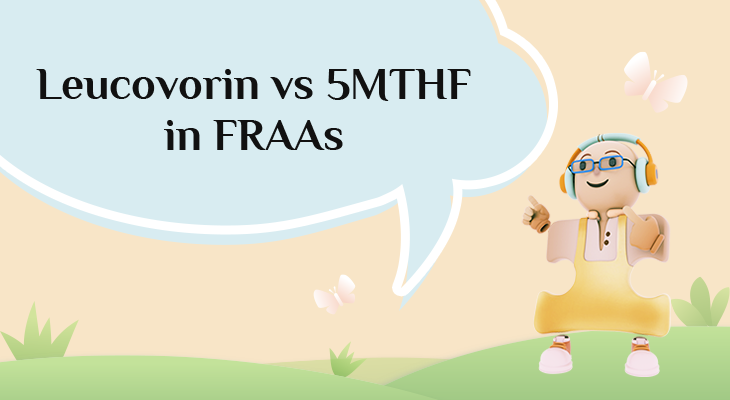
Introduction
Since the announcement by the White House of the “change of label” for the use of leucovorin in Cerebral Folate Deficiency (and symptoms related to autism) there has been a vast amount of interest and questions regarding this topic. This also includes the question of what is leucovorin, exactly, and how does it differ from other reduced folates such as 5-methyltetrahydrofolate (which happens to be a very popular over-the-counter supplement)? Is there a difference between the two, and how does this relate to the presence of folate receptor autoantibodies?
The Difference in Folates:
Leucovorin (also referred to as Folinic Acid) and 5-methyltetrahydrofolate (5-MTHF, L-Methylfolate) are both biologically active forms of folate that bypass the initial, problematic steps of folic acid metabolism. However, they are not always interchangeable. Their key difference lies in their position within the folate cycle and their mechanism of cellular uptake.
For the general population, 5-MTHF is often considered the superior supplemental form due to its role as the primary circulating folate. However, for individuals with folate receptor autoantibodies (FRα-Ab), the choice is critically dependent on the presence of these autoantibodies. Blocking and binding autoantibodies primarily disrupt the transport of 5-MTHF, making leucovorin a potentially more effective alternative, as it can utilize different transport mechanisms. Diagnosis and treatment must be guided by specific antibody testing (usually done via the FRAT® test) and clinical response.
Biochemical and Metabolic Fundamentals
To understand the clinical implications, one must first understand the metabolic pathways.
5-Methyltetrahydrofolate
5-Methyltetrahydrofolate is a primary, naturally occurring form of folate found in the bloodstream and the form that crosses the blood-brain barrier. It is the end-product of the methylenetetrahydrofolate reductase (MTHFR) enzyme cycle. 5-MTHF’s primary role is to donate its methyl group to homocysteine, remethylating it into methionine. This reaction, catalyzed by the vitamin B12-dependent enzyme methionine synthase, is crucial for:
- DNA Methylation: Epigenetic control of gene expression.
- Neurotransmitter Synthesis: Production of serotonin, dopamine, and norepinephrine.
- Myelination and Cellular Detoxification.
The dominant pathway for 5-MTHF uptake into many cells, especially in the brain and central nervous system, is via the High-Affinity Folate Receptor Alpha (FRα). This is a GPI-anchored receptor that internalizes folate via endocytosis. Other cells use the Reduced Folate Carrier (RFC), but FRα is critical for areas with high folate demand and protective barriers.
Folinic Acid (Leucovorin, 5-Formyl-THF)
Leucovorin, otherwise known as folinic acid, which has been in the news most recently, is a reduced, stable, “partially active” folate. It is not the form used in the methylation cycle. Essentially, leucovorin acts as a precursor. It must first be converted to 5,10-methylenetetrahydrofolate and then, via the MTHFR enzyme, to the active 5-MTHF. This conversion is generally efficient in individuals with a functioning MTHFR enzyme. In the case of folate receptor autoantibodies, leucovorin acid primarily utilizes the Reduced Folate Carrier (RFC), a bidirectional anion exchanger with lower affinity but higher capacity than FRα. While it may have some interaction with FRα, its primary and most reliable route into cells is via the RFC.
The Critical Issue: Folate Receptor Autoantibodies (FRα-Ab)
Folate receptor autoantibodies are immunoglobulins produced by the body that mistakenly target and bind to the body’s own FRα receptors. They come in two primary types, which have different mechanistic effects:
Blocking Antibodies bind directly to the folate-binding site of the FRα receptor. These particular antibodies physically block folate molecules from attaching to the receptor. This effectively shuts down the primary high-affinity transport pathway for 5-MTHF into vulnerable tissues, particularly the choroid plexus in the brain. This can lead to cerebral folate deficiency (CFD) even when blood levels of folate are normal.
Binding Antibodies, however, bind to a different, non-active site on the FRα receptor. They do not directly block folate binding. Instead, their binding is thought to trigger internalization and degradation of the receptor or activate an inflammatory response, ultimately reducing the number of functional receptors available on the cell surface.
Which Folate Form is Better for FRα-Ab?
The “better” form is determined by which transport pathway remains functional in the presence of these specific autoantibodies.
Bypassing the Blocked FRα Pathway: For individuals with Blocking Antibodies/Binding Antibodies, the primary gateway for 5-MTHF (the FRα receptor) is compromised. Leucovorin, with its primary reliance on the RFC transporter, can effectively bypass this blockade. The use of high-dose leucovorin to treat cerebral folate deficiency syndrome—a condition characterized by very low CSF 5-MTHF despite normal blood folate—is a well-established clinical protocol. This condition is often linked to the presence of FRα blocking antibodies.
Once inside the cell via the RFC, leucovorin is converted through a series of steps into 5,10-MTHF and then to 5-MTHF, ultimately restoring the active folate pool behind the “enemy lines” of the blocked receptor.
The Potential Limitations of 5-MTHF in FRα-Ab
If the dominant transport system (FRα) for 5-MTHF is blocked or downregulated by autoantibodies, oral 5-MTHF supplementation may struggle to reach its intracellular targets efficiently, particularly in the brain. Relying solely on 5-MTHF in the presence of significant blocking antibodies could be like trying to unlock a door with the wrong key, leading to a subtherapeutic response.
However, there may be some instances where 5-MTHF may be considered. An individual with both FRα-Ab and a significant MTHFR polymorphisms (e.g., C677T homozygous) may have a compounded folate processing defect. In this case, using 5-MTHF directly could be advantageous if a functional transport pathway exists. Some clinicians use a combination of folinic acid (to ensure delivery) and 5-MTHF (to provide immediate active folate) once transport is confirmed, though this requires careful monitoring.
Clinical Decision-Making and Recommendations
| Step | Action | Rationale |
|---|---|---|
| 1. Diagnosis | Test for Folate Receptor Autoantibodies. This is a specialized blood test (FRAT®) that screens for autoantibodies. | You cannot treat effectively without knowing the specific pathophysiology. The ratio of blocking to binding |
| 2. Initial Intervention | Physicians consider a trial of high-dose Folinic Acid as a first-line treatment if folate receptor autoantibodies are present. | Folinic acid’s use of the RFC provides a proven bypass mechanism around the blocked FRα pathway. Dosing must be supervised by a physician. |
| 3. Monitor Response | Physicians track clinical symptoms (e.g., neurological, cognitive, behavioral improvements). | Clinical improvement is the ultimate goal with the support of normalizing CSF folate levels. |
| 4. Consider 5-MTHF | If the response to folinic acid is suboptimal or if there is a known compounding MTHFR issue, a trial of high-dose 5-MTHF may be considered. | This assesses whether the RFC can transport sufficient 5-MTHF to meet metabolic demands or if the antibody profile is less disruptive to 5-MTHF transport than initially suspected. |
| 5. Continue with other prescribed therapies | Physicians continue with other additional therapies deemed appropriate. | The goal is to reduce symptoms, and increase patient response. |
Conclusion
Management of folate receptor autoantibodies is a complex medical condition that requires diagnosis through specialized testing (FRAT®) and a carefully managed treatment plan under the guidance of a knowledgeable physician such as a pediatrician, neurologist, metabolic specialist, or other medical professional.
The choice between folinic acid and 5-methyltetrahydrofolate for an individual with folate receptor autoantibodies is not a matter of one being universally “better” than the other. It is a targeted therapeutic decision based on the specific mechanism of the autoantibody insult. Leucovorin is often the preferred initial intervention due to its ability to utilize the Reduced Folate Carrier (RFC) and effectively bypass the FRα blockade caused by blocking antibodies. Its efficacy is well-documented in treating cerebral folate deficiency.
5-Methyltetrahydrofolate (5-MTHF) may be less effective as a first-line monotherapy in the presence of folate receptor autoantibodies but remains a viable option in certain contexts, such as when there are MTHFR polymorphisms.
Of course, self-treatment is strongly discouraged. As with any medical condition, consultation and supervision by a physician is required.
Disclaimer: This blog is for informational purposes only and does not constitute medical advice in any way. All diagnosis and treatment decisions must be made by a qualified healthcare professional.



